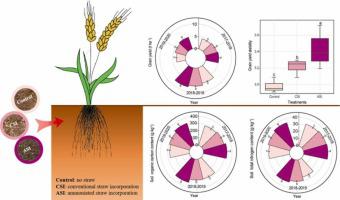Field Crops Research ( IF 5.8 ) Pub Date : 2022-05-17 , DOI: 10.1016/j.fcr.2022.108558 Yue Li , Hao Feng , Qin'ge Dong , Longlong Xia , Jinchao Li , Cheng Li , Huadong Zang , Mathias Neumann Andersen , Jørgen Eivind Olesen , Uffe Jørgensen , Kadambot H.M. Siddique , Ji Chen

|
Straw management strategies are highly important for maximizing the benefits of straw incorporation, which should aim to increase crop production while improving soil fertility. Ammoniated straw incorporation may be one of the potential candidates for achieving these goals. However, the effects of ammoniated straw incorporation on wheat yield, yield stability and soil properties as well as their potential relationships remain poorly understood. Based on an ongoing long-term field experiment commenced in 2011 on the Chinese Loess Plateau, we investigated the responses of soil properties, wheat yield and yield stability of winter wheat (Triticum aestivum L.) to ammoniated and conventional straw incorporation during 2017–2020. The three treatments were: (i) no straw (Control), (ii) conventional straw incorporation (CSI), and (iii) ammoniated straw incorporation (ASI). We found that the ASI treatment on average significantly increased wheat yield by 10.1% and yield stability by 19.5% compared to the CSI treatment, and significantly increased wheat yield by 26.9% and yield stability by 38.7% compared to the Control treatment. Changes in wheat yield and yield stability were positively related to ASI-induced increases in soil water storage. When compared to the Control and CSI treatments, the ASI treatment on average significantly increased soil organic carbon (SOC) content by 17.2% and 14.2% and total nitrogen (TN) content by 27.3% and 18.3% in 0–10 cm depth, and it significantly increased SOC content by 19.2% and 12.4% and TN content by 27.8% and 19.4% in 10–20 cm depth, respectively. There were positive relationships between changes in wheat yield and SOC and TN content. These results demonstrate that it is feasible to achieve higher wheat yield and yield stability while increasing SOC and TN content by optimizing straw management practices in semi-arid areas.



























 京公网安备 11010802027423号
京公网安备 11010802027423号